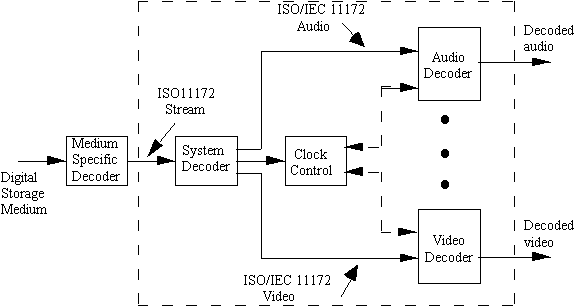INTERNATIONAL ORGANISATION
FOR STANDARDISATION
ORGANISATION INTERNATIONALE DE NORMALISATION
ISO/IEC JTC1/SC29/WG11
CODING OF MOVING PICTURES AND AUDIO
ISO/IEC JTC1/SC29/WG11
N
MPEG 96/
June 1996
| Source: | Leonardo Chiariglione - Convenor |
| Title: | Short MPEG-1 description |
MPEG-1 is a standard in 5 parts:
Part 1 addresses the problem of combining one or more data streams from the video and audio parts of the MPEG-1 standard with timing information to form a single stream as in Figure 1 below. This is an important fuction because, once combined into a single stream, the data are in a form well suited to digital storage or transmission.

Figure 1 -- Prototypical ISO/IEC 11172 decoder.
Part 2 specifies a coded representation that can be used for compressing video sequences - both 625-line and 525-lines - to bitrates around 1,5 Mbit/s. Part 2 was developed to operate principally from storage media offering a continuous transfer rate of about 1,5 Mbit/s. Nevertheless it can be used more widely than this because the approach taken is generic.
A number of techniques are used to achieve a high compression ratio. The first is to select an appropriate spatial resolution for the signal. The algorithm then uses block-based motion compensation to reduce the temporal redundancy. Motion compensation is used for causal prediction of the current picture from a previous picture, for non-causal prediction of the current picture from a future picture, or for interpolative prediction from past and future pictures. The difference signal, the prediction error, is further compressed using the discrete cosine transform (DCT) to remove spatial correlation and is then quantised. Finally, the motion vectors are combined with the DCT information, and coded using variable length codes.
Figure 2 below illustrates a possible combination of the three main types of pictures that are used in the standard.

Figure 2 -- Example of temporal picture structure.
Part 3 specifies a coded representation that can be used for compressing audio sequences - both mono and stereo. The algorithm is illustrated in Figure 3 below. Input audio samples are fed into the encoder. The mapping creates a filtered and subsampled representation of the input audio stream. A psychoacoustic model creates a set of data to control the quantiser and coding. The quantiser and coding block creates a set of coding symbols from the mapped input samples. The block 'frame packing' assembles the actual bitstream from the output data of the other blocks, and adds other information (e.g. error correction) if necessary.

Figure 3 -- Basic structure of the audio encoder
Part 4 specifies how tests can be designed to verify whether bitstreams and decoders meet the requirements as specified in parts 1, 2 and 3 of the MPEG-1 standard. These tests can be used by:
Part 5, technically not a standard, but a technical report, gives a full software implementation of the first three parts of the MPEG-1 standard. The source code is not publicly available.